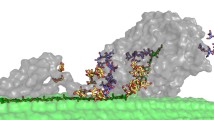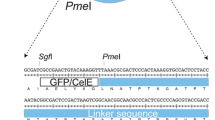Abstract
We report here the effect of adding different types of carbohydrate-binding modules (CBM) to a single-module GH7 family cellobiohydrolase Cel7A from a thermophilic fungus Talaromyces emersonii (TeCel7A). Both bacterial and fungal CBMs derived from families 1, 2 and 3, all reported to bind to crystalline cellulose, were used. Chimeric cellobiohydrolases with an additional S–S bridge in the catalytic module of TeCel7A were also made. All the fusion proteins were secreted in active form and in good yields by Saccharomyces cerevisiae. The purified chimeric enzymes bound to cellulose clearly better than the catalytic module alone and demonstrated high thermal stability, having unfolding temperatures (T m) ranging from 72 °C to 77 °C. The highest activity enhancement on microcrystalline cellulose could be gained by a fusion with a bacterial CBM3 derived from Clostridium thermocellum cellulosomal-scaffolding protein CipA. The two CBM3 fusion enzymes tested were more active than the reference enzyme Trichoderma reesei Cel7A both at moderate (45 °C and 55 °C) and at high temperatures (60 °C and 65 °C), the hydrolysis yields being two- to three-fold better at 60 °C, and six- to seven-fold better at 65 °C. The best enzyme variant was also tested on a lignocellulosic feedstock hydrolysis, which demonstrated its potency in biomass hydrolysis even at 70 °C.






Similar content being viewed by others
References
Boer H, Teeri TT, Koivula A (2000) Characterization of Trichoderma reesei cellobiohydrolase Cel7A secreted from Pichia pastoris using two different promoters. Biotechnol Bioeng 69:486–494
Boraston A, Warren RA, Kilburn DG (2001) Glycosylation by Pichia pastoris decreases the affinity of a family 2a carbohydrate-binding module from Cellulomonas fimi: a functional and mutational analysis. Biochem J 358:423–430
Boraston AB, Sandercock L, Warren RA, Kilburn DG (2003) O-glycosylation of a recombinant carbohydrate-binding module mutant secreted by Pichia pastoris. J Mol Microbiol Biotechnol 5:29–36
Boraston AB, Bolam DN, Gilbert HJ, Davies GJ (2004) Carbohydrate-binding modules: fine-tuning polysaccharide recognition. Biochem J 382:769–781
Carrard G, Koivula A, Söderlund H, Beguin P (2000) Cellulose-binding domains promote hydrolysis of different sites on crystalline cellulose. Proc Natl Acad Sci U S A 97:10342–10347
Cheek S, Krishna S, Grishin NV (2006) Structural classification of small, disulfide-rich protein domains. J Mol Biol 359:215–237
Davies G, Henrissat B (1995) Structures and mechanisms of glycosyl hydrolases. Structure 3:853–859
Demain AL, Newcomb M, Wu JH (2005) Cellulase, clostridia, and ethanol. Microbiol Mol Biol Rev 69:124–154
Fox JM, Jess P, Jambusaria RJ, Moo GM, Liphardt J, Clark DS, Blanch HW (2013) A single-molecule analysis reveals morphological targets for cellulase synergy. Nat Chem Biol 9:356–361
Gasteiger E, Gattiker A, Hoogland C, Ivanyi I, Appel RD, Bairoch A (2003) ExPASy: The proteomics server for in-depth protein knowledge and analysis. Nucleic Acids Res 31:3784–3788
Gietz RD, Woods RA (2002) Transformation of yeast by lithium acetate/single-stranded carrier DNA/polyethylene glycol method. Methods Enzymol 350:87–96
Grassick A, Murray PG, Thompson R, Collins CM, Byrnes L, Birrane G, Higgins TM, Tuohy MG (2004) Three-dimensional structure of a thermostable native cellobiohydrolase, CBH IB, and molecular characterization of the cel7 gene from the filamentous fungus, Talaromyces emersonii. Eur J Biochem 271:4495–4506
Guillén D, Sánchez S, Rodríguez-Sanoja R (2010) Carbohydrate-binding domains: multiplicity of biological roles. Appl Microbiol Biotechnol 85:1241–1249
Hall M, Rubin J, Behrens SH, Bommarius AS (2011) The cellulose-binding domain of cellobiohydrolase Cel7A from Trichoderma reesei is also a thermostabilizing domain. J Biotechnol 155:370–376
Igarashi K, Wada M, Hori R, Samejima M (2006) Surface density of cellobiohydrolase on crystalline celluloses. A critical parameter to evaluate enzymatic kinetics at a solid–liquid interface. FEBS J 273:2869–2878
Igarashi K, Koivula A, Wada M, Kimura S, Penttilä M, Samejima M (2009) High speed atomic force microscopy visualizes processive movement of Trichoderma reesei cellobiohydrolase I on crystalline cellulose. J Biol Chem 284:36186–36190
Igarashi K, Uchihashi T, Koivula A, Wada M, Kimura S, Okamoto T, Penttilä M, Ando T, Samejima M (2011) Traffic jams reduce hydrolytic efficiency of cellulase on cellulose surface. Science 333:1279–1282
Ilmén M, den Haan R, Brevnova E, McBride J, Wiswall E, Froehlich A, Koivula A, Voutilainen SP, Siika-aho M, la Grange DC, Thorngren N, Ahlgren S, Mellon M, Deleault K, Rajgarhia V, van Zyl WH, Penttilä M (2011) High level secretion of cellobiohydrolases in Saccharomyces cerevisiae. Biotechnol Biofuels 4:30–45
Imai T, Boisset C, Samejima M, Igarashi K, Sugiyama J (1998) Unidirectional processive action of cellobiohydrolase Cel7A on Valonia cellulose microcrystals. FEBS Lett 432:113–116
Kim T, Chokhawala HA, Nadler D, Blanch HW, Clark DS (2010) Binding modules alter the activity of chimeric cellulases: Effects of biomass pretreatment and enzyme source. Biotechnol Bioeng 107:601–611
Lehtiö J, Sugiyama J, Gustavsson M, Fransson F, Linder M, Teeri TT (2003) The binding specificity and affinity determinants of family 1 and family 3 cellulose binding modules. Proc Natl Acad Sci U S A 100:484–489
Lever M (1972) A new reaction for colorimetric determination of carbohydrates. Anal Biochem 47:273–279
Levy I, Shoseyov O (2002) Cellulose-binding domains: biotechnological applications. Biotechnol Adv 20:191–213
Linder M, Mattinen ML, Kontteli M, Lindeberg G, Ståhlberg J, Drakenberg T, Reinikainen T, Pettersson G, Annila A (1995) Identification of functionally important amino acids in the cellulose-binding domain of Trichoderma reesei cellobiohydrolase I. Protein Sci 4:1056–1064
McLean BW, Bray MR, Boraston AB, Gilkes NR, Haynes CA, Kilburn DG (2000) Analysis of binding of the family 2a carbohydrate-binding module from Cellulomonas fimi xylanase 10A to cellulose: specificity and identification of functionally important amino acid residues. Protein Eng 13(11):801–809
McLean BW, Boraston AB, Brouwer D, Sanaie N, Fyfe CA, Warren RAJ, Kilburn DG, Haynes CA (2002) Carbohydrate-binding modules recognize fine substructures of cellulose. J Biol Chem 277:50245–50254
Nikolova PV, Creagh AL, Duff SJ, Haynes CA (1997) Thermostability and irreversible activity loss of exoglucanase/xylanase Cex from Cellulomonas fimi. Biochemistry 36:1381–1388
Orr-Weaver TL, Szostak JW, Rothstein RJ (1981) Yeast transformation: a model system for the study of recombination. Proc Natl Acad Sci U S A 78:6354–6358
Reinikainen T, Ruohonen L, Nevanen T, Laaksonen L, Kraulis P, Jones TA, Knowles JK, Teeri TT (1992) Investigation of the function of mutated cellulose-binding domains of Trichoderma reesei cellobiohydrolase I. Proteins 14:475–482
Sambrook J, Russel DW (2001) Molecular cloning, 3rd edn. Cold Spring Harbor Laboratory, Cold Spring Harbor
Sherman F (2002) Getting started with yeast. Methods Enzymol 350:3–41
Suurnäkki A, Tenkanen M, Siika-aho M, Niku-Paavola ML, Viikari L, Buchert J (2000) Trichoderma reesei cellulases and their core domains in the hydrolysis and modification of chemical pulp. Cellulose 7:189
Tomme P, Driver DP, Amandoron EA, Miller RC Jr, Warren RAJ, Kilburn DG (1995) Comparison of a fungal (family I) and bacterial (family II) cellulose-binding domain. J Bacteriol 177(15):4356–4363
Tormo J, Lamed R, Chirino AJ, Morag E, Bayer EA, Shoham Y, Steitz TA (1996) Crystal structure of a bacterial family-III cellulose-binding domain: a general mechanism for attachment to cellulose. EMBO J 15:5739–5751
Tuohy MG, Walsh DJ, Murray PG, Claeyssens M, Cuffe MM, Savage AV, Coughlan MP (2002) Kinetic parameters and mode of action of the cellobiohydrolases produced by Talaromyces emersonii. Biochim Biophys Acta 1596:366–380
van Tilbeurgh H, Claeyssens M (1985) Detection and differentiation of cellulase components using low molecular mass fluorogenic substrates. FEBS Lett 187:283–288
van Zyl WH, Lynd LR, Den Haan R, McBride JE (2007) Consolidated bioprocessing for bioethanol production using Saccharomyces cerevisiae. Biofuels 108:205–235
Viikari L, Alapuranen M, Puranen T, Vehmaanperä J, Siika-Aho M (2007) Thermostable enzymes in lignocellulose hydrolysis. Adv Biochem Eng Biotechnol 108:121–145
Viikari L, Vehmaanperä J, Koivula A (2012) Lignocellulosic ethanol: from science to industry. Biomass Bioenergy 46:13–24
Voutilainen SP, Boer H, Linder MB, Puranen T, Rouvinen J, Vehmaanperä J, Koivula A (2007) Heterologous expression of Melanocarpus albomyces cellobiohydrolase Cel7B, and random mutagenesis to improve its thermostability. Enzyme Microb Tech 41:234–243
Voutilainen SP, Puranen T, Siika-Aho M, Lappalainen A, Alapuranen M, Kallio J, Hooman S, Viikari L, Vehmaanperä J, Koivula A (2008) Cloning, expression, and characterization of novel thermostable family 7 cellobiohydrolases. Biotechnol Bioeng 101:515–528
Voutilainen SP, Boer H, Alapuranen M, Jänis J, Vehmaanperä J, Koivula A (2009) Improving the thermostability and activity of Melanocarpus albomyces cellobiohydrolase Cel7B. Appl Microbiol Biotechnol 83:261–272
Voutilainen SP, Murray PG, Tuohy MG, Koivula A (2010) Expression of Talaromyces emersonii cellobiohydrolase Cel7A in Saccharomyces cerevisiae and rational mutagenesis to improve its thermostability and activity. Protein Eng, Des Sel 23:69–79
Wan W, Wang D, Gao X, Hong J (2011) Expression of family 3 cellulose-binding module (CBM3) as an affinity tag for recombinant proteins in yeast. Appl Microbiol Biotechnol 91:789–798
Xu GY, Ong E, Gilkes NR, Kilburn DG, Muhandiram DR, Harris-Brandts M, Carver JP, Kay LE, Harvey TS (1995) Solution structure of a cellulose-binding domain from Cellulomonas fimi by nuclear magnetic resonance spectroscopy. Biochemistry 34:6993–7009
Acknowledgments
Arja Kiema and Eila Leino are thanked for the skilful technical assistance. We also wish to thank Roal Oy, Finland, for providing the T. aurantiacus β-glucosidase and Chemtext, Italy, for providing the pre-treated A. donax material. This study was performed in NEMO, a project under EU’s seventh framework program, grant number 222699.
Author information
Authors and Affiliations
Corresponding author
Electronic supplementary material
Below is the link to the electronic supplementary material.
ESM 1
(PDF 31 kb)
Rights and permissions
About this article
Cite this article
Voutilainen, S.P., Nurmi-Rantala, S., Penttilä, M. et al. Engineering chimeric thermostable GH7 cellobiohydrolases in Saccharomyces cerevisiae . Appl Microbiol Biotechnol 98, 2991–3001 (2014). https://doi.org/10.1007/s00253-013-5177-2
Received:
Revised:
Accepted:
Published:
Issue Date:
DOI: https://doi.org/10.1007/s00253-013-5177-2




